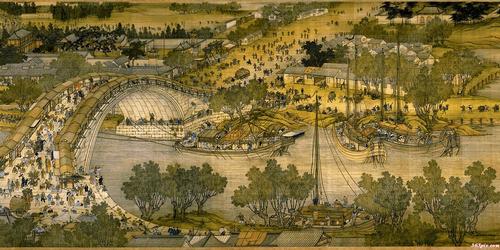Exporting Grain
 In the seventh month, the flow of rice entering the Imperial Capital (Kaifeng) via the Grand Canal arrives at a set pattern for fifteen days.
In the seventh month, the flow of rice entering the Imperial Capital (Kaifeng) via the Grand Canal arrives at a set pattern for fifteen days.
On the first day, one small ship carrying 24 sacks of rice reaches Kaifeng.
On the second day, five small ships carry 120 sacks of rice to Kaifeng.
On the third day, six medium-sized ships carry 360 sacks of rice to Kaifeng.
On the fourth day, seven large ships carry 840 sacks of rice to Kaifeng.
If this pattern continues, how many sacks were imported from day 1 to day 15?
Note: Kaifeng was the imperial capital of the Northern Song Dynasty
The answer is 279072.
This section requires Javascript.
You are seeing this because something didn't load right. We suggest you, (a) try
refreshing the page, (b) enabling javascript if it is disabled on your browser and,
finally, (c)
loading the
non-javascript version of this page
. We're sorry about the hassle.
2 solutions
this solution assumes that the size of the ship has no bearing. It looks purely like the # of ships by the day count multiple by the # of sacks in that day.... This is not the only answer if we are just looking for a number pattern... for instance you can also convert all the ships to the small ship equivalent and then use the pattern of (#of ships X 2)+5 as the number of small ships arriving pattern. Then multiple that by 24. The total sacks then becomes 3930264. The series then looks like this: 1, 5, 15, 35, 75, 155, 315... 24, 120, 360, 840, 1800, 3720, 7560...
Just take a look on the data given about the sacks in the question..
24, 120, 360, 840, ???????????
Thus,
24=(1)(2)(3)(4)
120=(2)(3)(4)(5)
360=(3)(4)(5)(6)
840=(4)(5)(6)(7)
Thus, it is nothing other than:
k = 1 ∑ 1 5 k ( k + 1 ) ( k + 2 ) ( k + 3 )
= k = 1 ∑ 1 5 k 4 + k = 1 ∑ 1 5 6 k 3 + k = 1 ∑ 1 5 1 1 k 2 + k = 1 ∑ 1 5 6 k
= 3 0 n ( n + 1 ) ( 6 n 3 + 9 n 2 +n-1) + 6 2 n ( n + 1 ) X 2 n ( n + 1 ) + 11 6 n ( n + 1 ) ( 2 n + 1 ) + 6 2 n ( n + 1 )
= 3 0 1 5 ( 1 6 ) (6( 1 5 3 )+9( 1 5 2 )+15-1) + 6 2 1 5 ( 1 6 ) X 2 1 5 ( 1 6 ) + 11 6 1 5 ( 1 6 ) ( 3 1 ) + 6 2 1 5 ( 1 6 )
= 178312+86400+13640+720
= 2 7 9 0 7 2
It was my easiest Level 5 problem...
F E E L I N G
H A P P Y
Log in to reply
I like the colours.
The most logical pattern to spot is:
2 4 × 1 5 = 1 2 0 1 2 0 × 2 6 = 3 6 0 3 6 0 × 3 7 = 8 4 0 8 4 0 × 4 8 = 1 6 8 0
and so on. The total number of sacks is therefore:
2 4 ∑ n = 0 1 4 ∏ k = 1 n k k + 4 = 2 4 ∑ n = 0 1 4 ( n n + 4 ) = 2 4 ∗ 1 1 6 2 8 = 2 7 9 0 7 2